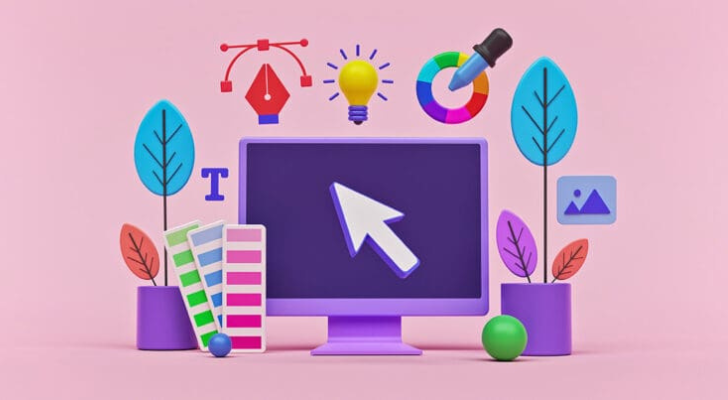Graphics Designing

Graphic Design
In the visually driven world of today, where first impressions are often visual, graphic design takes center stage as the silent storyteller. From sleek logos to eye-catching advertisements, graphic design is the visual language that communicates ideas, conveys messages, and shapes brand identities. This article explores the multifaceted world of graphic designing, shedding light on its artistic nuances, its role in various industries, and its transformative impact on visual communication.
1. The Art and Craft of Visual Communication: Graphic design is the marriage of art and communication. Designers use elements such as color, typography, imagery, and layout to convey messages effectively. Whether it's a website, a poster, or a social media graphic, the visual appeal and clarity of design are paramount.
2. Creating a Brand Identity: A brand's visual identity is often its first impression on the audience. Graphic designers play a crucial role in crafting logos, color schemes, and visual elements that encapsulate a brand's essence. Consistency in design across various platforms helps build brand recognition and trust.
3. User Experience (UX) Design: In the digital age, user experience is a key consideration. Graphic designers contribute to UX by creating intuitive and visually pleasing interfaces for websites, apps, and other digital platforms. A well-designed user interface enhances usability and ensures a positive interaction with the audience.
4. Print and Digital Design: Graphic design spans both print and digital mediums. Print designers focus on creating visually appealing materials like brochures, posters, and packaging. Meanwhile, digital designers specialize in crafting online experiences, including website layouts, social media graphics, and interactive elements.
5. Infographics and Data Visualization: Complex data can be made accessible and engaging through the art of infographics. Graphic designers use visual elements to simplify information, making it easier for audiences to understand and retain. Effective data visualization is a powerful tool for storytelling and conveying complex ideas.
6. Illustration and Typography: Beyond layout and color, graphic designers often delve into the realms of illustration and typography. Unique illustrations add personality to designs, while thoughtful typography enhances readability and reinforces the overall visual identity. The combination of these elements contributes to the aesthetics and impact of the design.
7. Evolution with Technology: Advancements in technology have transformed the graphic design landscape. Design software, 3D modeling tools, and virtual reality experiences have expanded the possibilities for designers. Staying updated with emerging technologies is crucial for graphic designers to remain at the forefront of their craft.
8. Collaboration and Feedback: Graphic design is often a collaborative process. Designers work closely with clients, marketing teams, and other stakeholders to understand the vision and objectives. Incorporating feedback is essential for refining designs and ensuring they align with the goals and expectations of the project.
🚀 Master Top Web & App Frameworks
Explore structured tutorials for AngularJS, React, Laravel, Flutter, PHP, SQL, and more.
📘 Introduction to AngularJS
Introduction to AngularJS overview
📘 Introduction to Laravel
Learn Introduction to Laravel in Laravel with real-world examples and step-by-step guide.
📘 Introduction to CodeIgniter
An introduction to Introduction to CodeIgniter in CodeIgniter with examples.
📘 Introduction to React
Quick overview and guide to Introduction to React in React JS.
📘 Introduction to Flutter
An easy-to-follow tutorial on Introduction to Flutter in Flutter mobile app development.
📘 Introduction to Kotlin
Learn Introduction to Kotlin in Kotlin programming with examples for Android or backend apps.
📘 Introduction to PHP
Understand Introduction to PHP in PHP with practical examples and clear syntax.
📘 Introduction to SQL
Understand Introduction to SQL in SQL for effective database querying and management.
📘 Introduction to Bootstrap 5
Understand Introduction to Bootstrap 5 in Bootstrap 5 for responsive web design using pre-built components.
📘 Introduction to HTML
Understand Introduction to HTML in HTML to create structured, semantic, and accessible web content.
📘 Introduction to CSS
Explore Introduction to CSS in CSS to enhance web design using styling properties and layout techniques.
📘 Introduction to JavaScript
Understand Introduction to JavaScript in JavaScript to build dynamic and interactive web experiences.
📘 Introduction to Node.js
Explore Introduction to Node.js in NodeJS for backend development using JavaScript and non-blocking architecture.
📘 Introduction to AJAX
Understand Introduction to AJAX in AJAX to update web pages without full reloads using asynchronous JavaScript and XML.
📘 Introduction to jQuery
Learn Introduction to jQuery in jQuery to write less and do more with simplified JavaScript operations and cross-brow...
📰 Latest Blog Posts
Insights, tutorials, and tech stories from our experts.
Transform Your Passion into a Web Development Career
Do you love tech? Let’s turn it into a profession with full stack development.
Not Just Coding – Career-Focused Full Stack Training
We don’t just teach code—we teach how to get jobs with it.
Learn, Code, Build, Get Hired – Full Stack Program
A step-by-step path to go from beginner to hired developer.
BCA/MCA/B.Tech? Start Building Real Websites Now!
Already pursuing IT education? Now build real websites with us!
Offline Full Stack Training in Dwarka & Uttam Nagar – Limited Seats!
Join our offline batch in Dwarka or Uttam Nagar and learn full stack development practically.
Struggling in Interviews? Build Skills That Get You Hired!
Facing rejections in job interviews? Build the right skills and project experience.


